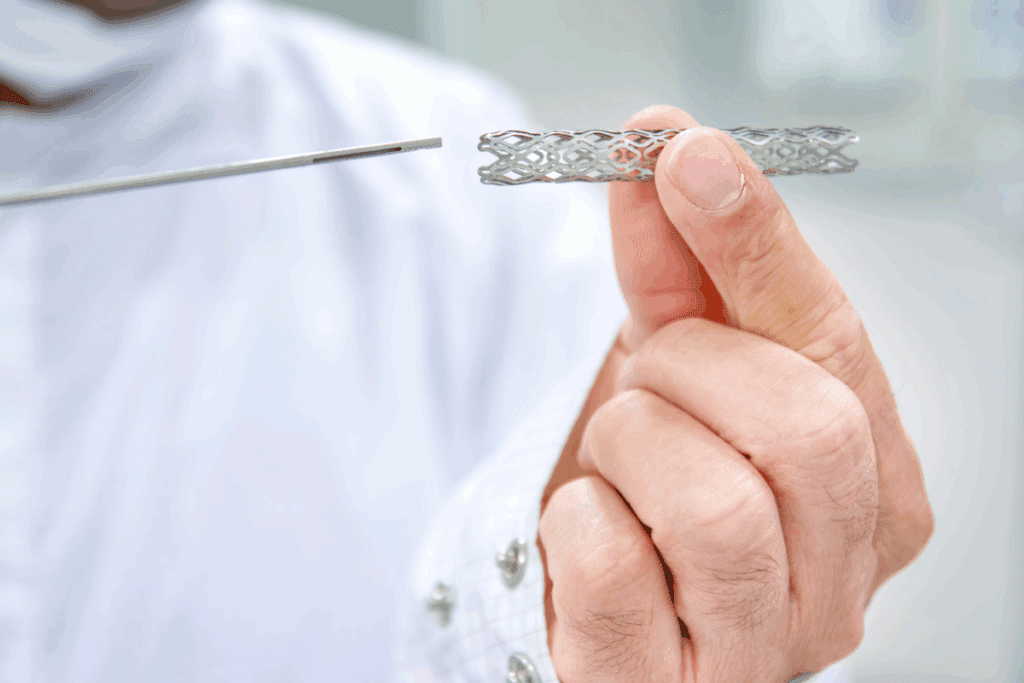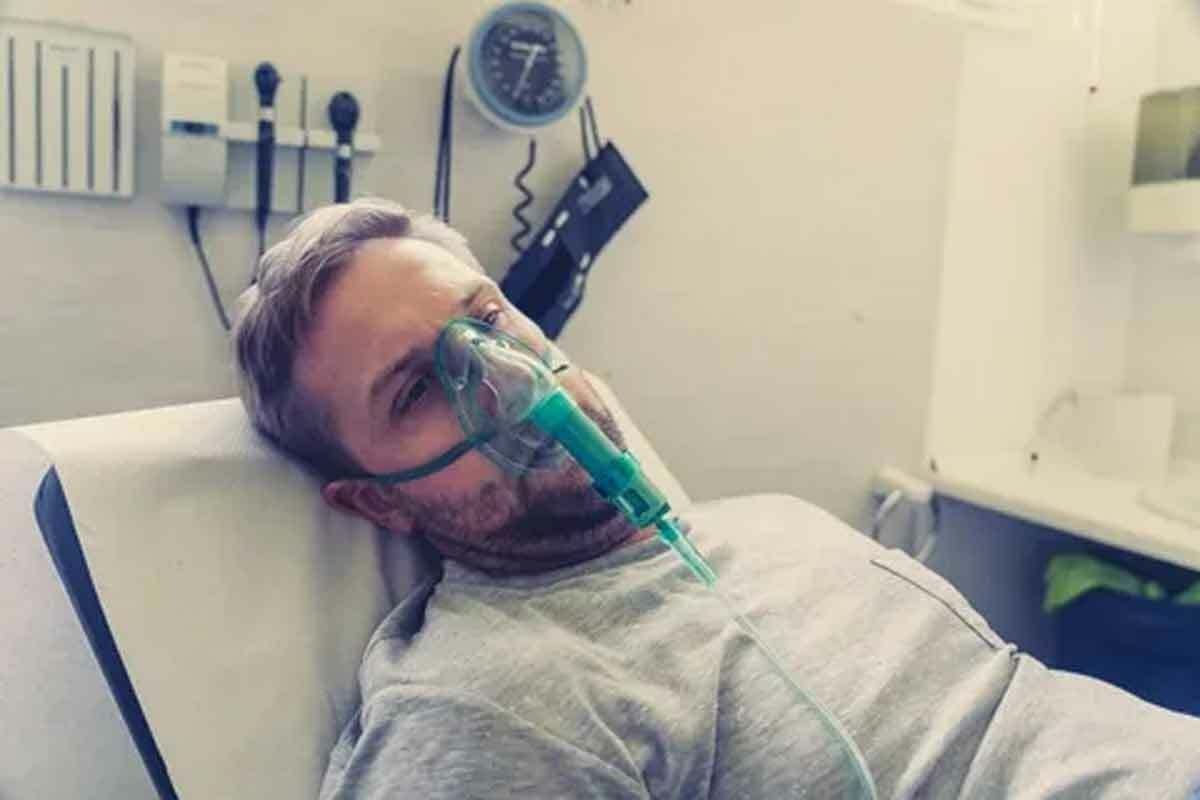Last Updated on November 26, 2025 by Bilal Hasdemir

At Liv Hospital, we know you might worry about your cardiac stents moving after they’re put in. Stents are key to fixing blocked arteries. We focus on your care, making sure your stent stays stable.
After they’re placed, stents are meant to stay put. But it’s important to know about the dangers of stent movement. We’ll look at how stents are made and put in to stay stable. We’ll also talk about how we keep you safe from risks.
Key Takeaways
- Cardiac stents are designed to remain in place after deployment.
- Proper deployment techniques are key to stent stability.
- Knowing the risks of stent movement is very important.
- Liv Hospital is dedicated to top-notch cardiac care and keeping you safe.
- We have safety steps to lower risks.
Understanding Cardiac Stents and Their Purpose

Cardiac stents have changed how we treat coronary artery disease (CAD). They offer a less invasive way to keep arteries open. These small, wire mesh tubes are placed in the coronary arteries to improve blood flow to the heart.
What Are Cardiac Stents?
Cardiac stents are used with angioplasty to treat blocked or narrowed arteries. They help keep arteries open, improving blood flow to the heart. This reduces symptoms like chest pain and shortness of breath.
Over time, stent design has improved. Now, stents are made from materials that are safe and work well.
Types of Cardiac Stents Used in CAD Treatment
There are different types of cardiac stents for CAD treatment. Each has its own benefits and features.
- Bare Metal Stents: These are the first stents made from metal mesh. They support the artery to keep it open.
- Drug-Eluting Stents: These stents release medication to prevent the artery from narrowing again. They are popular for their effectiveness.
- Bioresorbable Stents: A newer stent that dissolves over time. They might reduce long-term complications.
How Stents Are Deployed in Coronary Arteries
Deploying cardiac stents involves a procedure called percutaneous coronary intervention (PCI). A catheter guides the stent to the blocked artery. The stent is then expanded to fit the artery’s diameter, keeping it open.
It’s important to deploy stents correctly. This ensures they work as they should. The skill of the cardiologist is key to successful stent deployment.
The Engineering Behind Stent Stability

Understanding stent stability is key to seeing how advanced cardiac stents are. A stable stent is vital for its success and the patient’s health. We’ll look at design, materials, and tech that make stents stable.
Design Features That Ensure Stent Fixation
Modern cardiac stents have special features for stability. These include:
- Flexible Struts: Let the stent fit the artery’s curve.
- Radial Strength: Keeps the stent’s shape and opens the artery.
- Surface Texture: Some stents have a textured surface for better wall integration.
Materials Used in Modern Cardiac Stents
Stents are made from various materials, each with its own benefits. The most common are:
| Material | Properties | Benefits |
| Stainless Steel | Strong, durable | Provides radial strength |
| Cobalt-Chromium | High strength, thin struts | Improves flexibility and reduces thrombosis risk |
| Platinum-Chromium | Good radiopacity, flexibility | Enhances visibility during imaging, improves placement |
Evolution of Stent Technology for Enhanced Stability
Stent technology has grown a lot, focusing on better stability and fewer problems. Key advancements include:
- Drug-Eluting Stents: Release medication to stop restenosis.
- Bioresorbable Stents: Dissolve over time, reducing complications.
- Improved Delivery Systems: Make stent placement more precise.
These updates have made stents safer and more effective. They lower the chance of stent movement and improve patient results.
Can a Cardiac Stent Move After Placement?
It’s important to know how cardiac stents behave after they’re put in. These devices help keep arteries open, improving blood flow to the heart. Sometimes, stents can move or migrate, which is a concern.
The Normal Behavior of Properly Deployed Stents
When a stent is correctly placed, it’s meant to stay there forever. It expands against the artery walls, acting as a scaffold. Over time, the body’s cells cover the stent, making it a part of the artery.
Ensuring the stent stays in place is critical. Doctors use advanced imaging and precise methods to place stents correctly. Most stents stay where they’re meant to without moving.
Statistical Data on Stent Migration Incidents
Stent migration is rare, but it’s good to know the numbers. Studies show:
- Less than 1% of stents migrate in most studies.
- Improper sizing, complex lesions, and poor expansion increase migration risk.
- New stent designs and better deployment methods have lowered migration rates in the last ten years.
These facts reassure us that stent movement is rare when done right.
Factors That Influence Long-Term Stent Stability
Several things can affect how well a stent stays in place. These include:
- Stent Design and Material: New stents are made to be safe and last long. Drug-eluting stents, for example, release medicine to prevent blockages.
- Deployment Technique: How the stent is put in matters a lot. Getting the size and position right is key.
- Patient-Specific Factors: Things like vessel size, lesion type, and overall health can affect stent stability.
Knowing these factors helps doctors reduce risks and ensure stents work well over time.
Deployment Techniques That Minimize Stent Movement
Putting in a cardiac stent needs to be done with great care. Many methods have been created to keep the stent in place. These methods aim to place the stent correctly and keep it stable, lowering the chance of problems.
Floating-Wire Method Explained
The floating-wire method is a way to lower the risk of stent movement during deployment. It uses a guidewire that moves freely in the coronary artery. This helps reduce the forces on the stent, making it less likely to move.
This technique is very effective in keeping the stent in place, even in tough coronary artery lesions. It allows for a more precise placement of the stent, which is key to its long-term success.
Rapid Right Ventricular Pacing Technique
Rapid right ventricular pacing is another method to keep the stent stable during deployment. It involves pacing the right ventricle quickly to lower the heart’s output. This reduces the movement of the coronary arteries, helping the stent to deploy more steadily.
This method is very useful when the stent is placed near the heart’s apex. It helps to reduce the heart’s motion, making the stent placement more precise.
Physician Expertise and Its Impact on Stent Stability
The skill of the doctor putting in the stent is very important for its stability. Experienced doctors are better at handling complex cases and using the right techniques. Their knowledge and experience are key in choosing the best method for each patient.
Research shows that the success of stent deployment greatly depends on the doctor’s experience. High-volume centers often have better results, with fewer stent migrations and complications. So, patients need to be treated by experienced doctors with a good track record in stent deployment.
Risk Factors for Stent Displacement
The stability of a cardiac stent depends on many factors. These include the body’s anatomy and specific health conditions. Even though modern stents are made to last, some risks can cause them to move or lead to other problems.
Anatomical Challenges That May Affect Stent Stability
Stent stability can be affected by the body’s shape. For example, tortuous or curved vessels can put uneven pressure on the stent. This might cause it to move. Also, stents in areas with significant calcification might not stay in place well because the artery wall is hard.
Improper Sizing and Placement Concerns
Getting the stent’s size and placement right is key to its stability. If the stent is too small or too big, it might not stay in place well. Also, if it’s put in the wrong spot, it can’t work right.
Patient-Specific Factors That May Increase Risk
Some things about a patient can affect how well a stent works. These include diabetes, renal failure, and complex coronary anatomy. Lifestyle choices like smoking and not following treatment plans can also play a role.
Knowing these risks helps doctors do better for their patients. They can work to make sure stents are as effective as possible for treating coronary artery disease.
Recognizing Symptoms of Stent Failure or Movement
It’s important to know the signs of stent failure or movement. After a stent is put in, patients should watch for possible problems.
Common Warning Signs to Monitor
Here are some signs that might mean the stent is not working right:
- Chest Pain: A return of angina-like chest pain
- Shortness of Breath: Trouble breathing or feeling out of breath even when sitting or lying down
- Recurrence of CAD Symptoms: Feeling like you did before the stent was put in
It’s key to watch these signs closely and talk to your doctor if you notice anything off.
Chest Pain and Shortness of Breath After Stent Placement
Chest pain and trouble breathing are serious signs that need quick action. Some discomfort is normal after a stent is placed. But if the pain or breathing trouble doesn’t go away, it could mean a problem with the stent.
Chest pain after a stent might feel like the angina you had before. This could mean the stent isn’t working right or there’s another issue with the artery.
When to Seek Immediate Medical Attention
If you have any of these symptoms, get help right away:
- Severe chest pain or pressure
- Shortness of breath that doesn’t get better with rest
- Dizziness or fainting
- Rapid or irregular heartbeat
Quick medical help can figure out what’s wrong and help fix it.
Imaging and Monitoring Cardiac Stents
Imaging is key in checking how well cardiac stents work. After a stent is put in, it’s important to use the right imaging to see if it’s working properly. This helps find any problems early on.
Visibility on Chest X-rays
Most cardiac stents can’t be seen well on a chest X-ray. This is because they’re made from materials that don’t show up much on X-rays. But some stents might show up a bit, depending on their metal type.
Table: Visibility of Stents on Different Imaging Modalities
| Imaging Modality | Stent Visibility |
| Chest X-ray | Limited |
| Angiography | High |
| CT Scan | High |
Advanced Imaging Techniques for Stent Visualization
For a close look at cardiac stents, advanced imaging is needed. Angiography gives clear views of the stent and arteries. CT angiography is another good option, as it’s non-invasive and shows the stent and blood vessels well.
Regular Monitoring Protocols After Stent Placement
It’s important to keep an eye on stents after they’re placed. This means regular check-ups, stress tests, and sometimes more detailed imaging. The doctor will decide how often these checks should happen.
Patients should stick to a follow-up plan to keep an eye on their stent. This way, any problems can be caught early and dealt with quickly. It’s a smart way to make sure the stent is working right.
MRI Compatibility with Cardiac Stents
Many patients with heart stents wonder if they can have an MRI. With new medical tech, knowing if stents work with MRI scans is key.
Can You Have an MRI with Heart Stents?
Most heart stents today work well with MRI scans. But how well they work can depend on the stent type and the MRI setup. Usually, people with stents can get MRI scans, but they need to be careful.
Understanding MRI-Safe vs. MRI-Conditional Stents
It’s important to know the difference between MRI-safe and MRI-conditional stents. MRI-safe stents are safe in any MRI setting. MRI-conditional stents are safe in certain MRI conditions. Knowing your stent type is key to MRI safety.
Our medical team stresses checking your stent type and MRI safety. This info is usually in your medical records or from the stent maker.
Precautions and Protocols for MRI After Stent Placement
Before an MRI, patients with stents need to follow certain steps. These include:
- Telling your doctor about your stent.
- Sharing the tent details and its maker.
- Follow any special instructions from your doctor or the MRI place.
By taking these steps, patients can safely get MRI scans when needed. Also, new stent tech is making MRI scans safer and more useful for patients.
Preventing Complications and Ensuring Stent Longevity
To keep a cardiac stent working well, it’s important to take medicine as told, make lifestyle changes, and get regular check-ups. These steps help lower the chance of problems and keep the stent effective.
Medication Adherence After Stent Placement
After getting a cardiac stent, it’s key to take your medicine as directed. This helps avoid stent thrombosis (clot in the stent) and restenosis (artery narrowing). You’ll likely be on antiplatelet therapy, like aspirin and P2Y12 inhibitors (e.g., clopidogrel).
These drugs stop platelets from clumping and forming clots. It’s vital to take your medicine as directed. Skipping doses or stopping without a doctor’s okay can raise the risk of stent problems. Studies show that sticking to dual antiplatelet therapy for 6 to 12 months can cut stent thrombosis risk by up to 90%.
| Medication | Purpose | Typical Duration |
| Aspirin | Antiplatelet agent | Indefinitely |
| P2Y12 Inhibitors (e.g., clopidogrel) | Antiplatelet agent | 6-12 months |
Lifestyle Modifications for Patients with CAD and Stents
Changing your lifestyle is key for patients with CAD and stents. Quitting smoking is a big step, as it can cut heart disease risk by up to 50%. Other lifestyle changes include:
- Eating a heart-healthy diet with lots of fruits, veggies, whole grains, and lean proteins
- Doing regular physical activity, like brisk walking, for at least 30 minutes daily
- Keeping a healthy weight to ease heart strain
- Managing stress with meditation or yoga
Follow-up Care Schedule and Importance
Regular check-ups are vital to monitor the stent and heart health. Work with your doctor to set up a follow-up plan. This usually includes:
- A visit within a few weeks after the stent
- Check-ups every 6-12 months to check the stent and heart health
- Stress tests or other tests, as your doctor suggests
These visits help your doctor check your condition, change meds if needed, and talk about any issues. Following this schedule helps catch and fix any problems early.
Conclusion: The Reliability of Modern Cardiac Stents
Modern cardiac stents have changed how we treat heart disease. They offer a safe and reliable option for patients. We’ve looked at how their design, materials, and how they’re put in place make them stable.
The data shows that stents usually stay in place well. But things like the right size and where they’re placed matter a lot. Also, how the patient is doing affects how stable the stent is.
It’s key for patients to follow their care plan after the procedure. This includes taking medicine and making healthy lifestyle choices. Regular check-ups and monitoring are also important for keeping the stent safe and the heart healthy.
We believe that modern cardiac stents are made to give long-term relief from heart disease symptoms. Thanks to new stent technology and ongoing care, patients can trust their treatment is reliable and safe.
FAQ
Can a cardiac stent move after it’s been placed?
It’s rare, but a cardiac stent can move after placement. Modern stents and deployment methods have made this risk much lower.
What are the symptoms of stent failure or movement?
Signs of stent failure or movement include chest pain and shortness of breath. Fatigue and palpitations are also symptoms. If you notice these, get medical help right away.
Can I have an MRI with a cardiac stent?
Most modern stents are safe for MRI scans under certain conditions. Always tell your doctor about your stent before an MRI and follow their advice.
How do I know if my stent is working properly?
Your doctor will check if your stent is working properly through regular visits. They might use chest X-rays or other tests to see how your stent is doing.
Are stents visible on chest X-rays?
Yes, most cardiac stents show up on chest X-rays. This lets doctors check their position and if they’re working well.
What can I do to prevent stent complications?
To lower the risk of stent problems, take your medicine as directed. Eat well, exercise, and go to all your doctor’s appointments.
Can stent movement be prevented?
Some stent movement risks can’t be avoided, but proper care and correct stent size can help. Your doctor will focus on these to reduce the risk.
What happens if I need an MRI with a stent?
If you need an MRI with a stent, your doctor will check if it’s safe. They’ll tell you what precautions to take or special steps to follow.
How often should I have follow-up care after stent placement?
Your doctor will set a follow-up schedule just for you. Regular visits and checks help make sure your stent is working well.
Can lifestyle modifications improve stent longevity?
Yes, living a healthy lifestyle can help your stent last longer. Eating well, exercising, and managing stress are all good for your heart
References
- Puri, R., et al. (2018). Imaging and management of coronary stent complications. JACC: Cardiovascular Imaging, 11(8), 1260-1273.
https://www.sciencedirect.com/science/article/pii/S1936878X18304014






